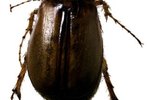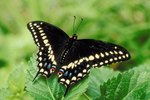
According to the United States Air Force (USAF) Public Health Source, over 700 species of sand flies exist, 70 of which are capable of transmitting diseases to humans. Sand flies get their name not from their habitat, but from the brownish color of their adult bodies. The life cycle of a sand fly has four stages.
Eggs
A blood meal is typically required for adult females to develop eggs. Female sand flies lay between 30 and 70 eggs on a moist surface like soil, which hatch within two weeks. At first sand fly eggs are oval-shaped and pale. Once exposed to air, the eggs turn brown. According to the University of Florida, the eggs measure 0.31mm long and 0.10mm wide.
Larvae
Caterpillar-like larvae hatch from eggs through a J-shaped crack. Four different stages, or instars, of larval development occur over a period of around two weeks, each one larger than the one before. The newly hatched first instar larvae have two rear bristles, or whiskers, while all later larval developments have four rear bristles. Larvae feed on dead organic matter and are found living in moist areas, such as in animal burrows.
Pupae
To prepare for the pupal stage, the sand fly larvae attach themselves to a substrate. During this stage, each larva resembles a butterfly chrysalis as it develops into adults and grows wings. Sand flies are immobile during this life cycle stage and do not eat. The pupal stage occurs over a period of five to ten days, according to the USAF Public Health Source.
Adults
Sand flies emerge from their pupal stage as adults at night, shortly after they develop their wings, which are a characteristic V shape when erected. Adult male and female sand flies feed on sugary sap from plants. Sand flies are active during the early morning and evening hours when temperatures are cooler and humidity is lower. The total time from egg to adult takes five weeks.
References
Photo Credits
-
Hemera Technologies/AbleStock.com/Getty Images
Writer Bio
Amanda Williams has been writing since 2009 on various writing websites and blogging since 2003. She enjoys writing about health, medicine, education and home and garden topics. Williams earned a Bachelor of Science in biology at East Stroudsburg University in May 2013. Williams is also a certified emergency medical technician.




